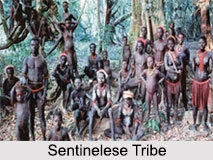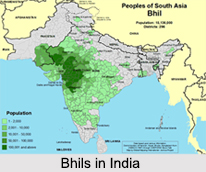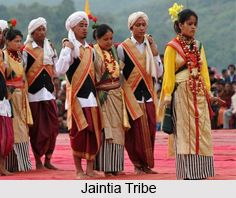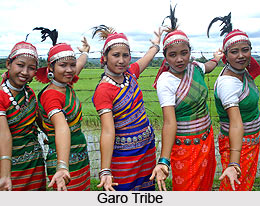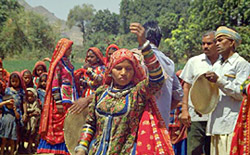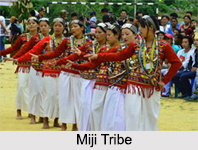
The Miji Tribe, also known by the names of Sajolang and Damai, is a distinctive community inhabiting the districts of West Kameng, East Kameng, and a small region of Kurung Kumey in Arunachal Pradesh, India. Miji people mainly reside near the lower parts of the sub-Himalayan hills that border Assam. The Miji people proudly speak the Sajalong language, which is an integral part of their identity and heritage.
Origin of the Miji Tribe
The term "Miji" is derived from two distinct words: "Mai," meaning fire, and "ji," meaning Giver. This name came into existence after the Aka (Hrusso) community recognized the Sajolang/ Dammai people for their gracious assistance during the pre-historic period. The Miji Tribe, thus, embodies the spirit of generosity and warmth.
Society of Mishmi Tribe
The Miji Tribe is part of the larger Mishmi community, which consists of three distinct groups: Digaru, Idu, and Miju. Each group possesses its own distinctive dialects, enriching the linguistic tapestry of the region. The Miji people rely primarily on the land and forest produce for their livelihood. Agriculture is a significant economic resource for them, while their remarkable weaving skills have gained recognition. They produce a wide range of exquisite products, including shawls, blouses, jackets, skirts, coats, bamboo baskets, bead-necklaces, and more. The Miji people actively engage in trade to showcase and share their unique craftsmanship.
Marriage customs hold significant importance among the Miji Tribe, and the process typically involves negotiations between the families of the bride and groom. The parents of the groom offer a nominal bride price as a gesture of respect and commitment. In terms of social systems, inheritance follows the male line within the Miji community. All the sons receive equal shares of the property left behind by the parents. The eldest son inherits the main house, which signifies his role as the head of the family. This practice underscores the strong sense of kinship and mutual support within the Miji Tribe, as siblings play a vital role in upholding family traditions and maintaining social cohesion.
Culturally and linguistically, the Miji and Hrusso Akas form a cognate group, sharing common features and historical ties. Their ancestors, known as Bor (Robo), are considered the elder brothers of the Tanis (Nyibo). This familial relationship is reminiscent of the brotherhood shared with other tribes such as the Nyishis, Apatanis, Tagins, Galos, and Adis, who possess both commonalities and distinct characteristics. The Miji Tribe`s cultural and linguistic affinity with the Hrusso Akas highlights the interconnectedness of communities within the region.
Religious Beliefs of Miji Tribe
The Miji Tribe predominantly adheres to Animism, a belief system deeply rooted in the worship of nature and the divine essence within it. Nature, considered a reflection of God, holds immense significance in the spiritual practices of the Miji people. They perceive the presence of God in every aspect of the natural world, be it trees, water tributaries, or even stones. This profound connection to nature guides their way of life and shapes their religious rituals.
Furthermore, the Miji Tribe exhibits traces of Buddhist influence, which can be attributed to long-standing cultural interactions with neighboring Buddhist tribes to the west. The celebration of Losar, the Tibetan New Year, and the usage of prayer flags are notable indications of this influence. These Buddhist elements contribute to the diverse religious tapestry of the Miji community, reflecting their openness to embracing different spiritual practices while preserving their distinct animistic beliefs.
Festivals of Miji Tribe
The Miji Tribe celebrates a variety of festivals throughout the year, with Chindang being the most prominent. Marked every 15th of October, Chindang holds special significance for the Miji community residing in the Lada circle of the East Kameng district, the Sarli region of the Kurung Kumey district, and the Nafra and Bomdila Sub-Divisions of the West Kameng district. Some Miji individuals who settled in the Assam-Arunachal border towns of Sessa and Bhalukpong also participate in this festival due to improved access to facilities.
Traditional Attire of Mishmi Tribe
The traditional attire of Miji women is an exquisite sight to behold. They wear ankle-length white garments complemented by beautifully decorated red jackets. Unlike many other tribes in Arunachal Pradesh, the Miji people adorn themselves with silver ornaments and necklaces made from glass or brass. Indigenous cosmetics, derived from pine resin and coal, are used during special occasions, particularly marriage ceremonies.
The Miji community`s traditional dress comprises several elements, including Grii za (cotton cloth), ornamental beads, a silver or bamboo crown, Gichin thay (a long red cotton cloth serving as a belt), waichin (sword), Lai lo (cotton cloth to cover the lower portion of the legs), Lai Drangk (ornamental beads to keep Lai lo intact), as well as various necklaces, bangles, and ear tops.
Distinct Groups of Miji People
The Miji tribe or Miji people are classified into three distinct categories:
Western Miji: The Western Miji people reside in the Bomdila-Nafra division of the West Kameng district. This subgroup is widely recognized as the Western Miji and contributes to the cultural diversity of the region.
Eastern Miji: Inhabiting the Lada-Bana tract within the East Kameng district, the Eastern Miji people have established harmonious relations with their brethren tribe, the Akas, and the larger Nyishi community. The Eastern Miji share minimal differences in language vocabulary with their western counterparts and, together, they constitute the broader Sajolang group.
Northern Miji: The Northern Miji, also known as the Bangru or Bengru in China, represents a vulnerable and enigmatic group within the Miji Tribe. Little research has been conducted on this group, and they live in relative isolation. They primarily reside in the Sarli circle and several adjacent villages in the Kurung Kumey district. The Northern Miji group remains largely attached to their roots, and their unique cultural practices.
Preservation of Culture and Heritage
The Miji Tribe takes great pride in preserving their rich cultural heritage. Despite the challenges of modernization and external influences, they strive to maintain their traditional practices and customs. The Miji people pass down their ancestral knowledge through oral traditions, storytelling, and vibrant cultural festivals. These events serve as important platforms for showcasing their traditional dances, music, and art forms.
One of the remarkable aspects of Miji culture is their deep-rooted connection with nature. They have a profound understanding of the local flora and fauna, which is reflected in their rituals, folklore, and traditional healing practices. The Miji people believe in the harmonious coexistence of humans and the natural world, and they actively participate in conservation efforts to protect their pristine surroundings.
The Miji Tribe, also known as the Sajolangs or Dammais, represents a unique and vibrant community within the diverse landscape of Arunachal Pradesh, India. With their distinct language, traditional attire, and exceptional craftsmanship, the Miji people are the torchbearers of a rich cultural heritage. As the world progresses, it is imperative to recognize and celebrate the cultural diversity and indigenous wisdom that the Miji Tribe offers. By supporting their efforts in preserving their traditions, the society can ensure the continuity of their invaluable cultural legacy for generations to come.

















